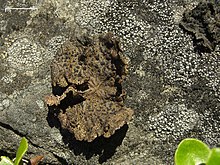| Umbilicaria torrefacta | |
|---|---|

| |
| Scientific classification | |
| Domain: | Eukaryota |
| Kingdom: | Fungi |
| Division: | Ascomycota |
| Class: | Lecanoromycetes |
| Order: | Umbilicariales |
| Family: | Umbilicariaceae |
| Genus: | Umbilicaria |
| Species: | U. torrefacta
|
| Binomial name | |
| Umbilicaria torrefacta | |
| Synonyms[1] | |
|
List
| |
Umbilicaria torrefacta is a species of saxicolous (rock-dwelling), foliose lichen in the family Umbilicariaceae.[2] It is an arctic-alpine species with a circumpolar distribution and is widely distributed within the Holarctic realm, specifically within the Palearctic and Neoarctic biogeographical regions. Characteristic features of Umbilicaria torrefacta include the lace-like fringe in its lobes and the plates on the underside of the thallus. One common name, punctured rock-tripe, refers to the distinctive sieve-like perforations on the thallus margins.
The species was scientifically described in 1777 by John Lightfoot and later classified under the genus Umbilicaria by Heinrich Schrader in 1794. Because of its somewhat variable morphology, this species has often been misidentified historically and described under different names, resulting in an extensive synonymy. In 2017, a lectotype specimen was designated for the species, clarifying its taxonomic status. Molecular phylogenetics studies have revealed complex relationships within the family Umbilicariaceae, resulting in the revision of the genus Umbilicaria. U. torrefacta is a member of Gyrophora, a subgenus characterised by species with circular ridges on the discs of their apothecia; rigid, non-pustulate thalli; and specific secondary metabolites, such as gyrophoric acid and stictic acid.
Umbilicaria torrefacta has distinct spectral properties, transmitting very little light and significantly altering the spectral signature of rock surfaces. It shows slow initial growth and delayed reproduction, with reproductive output increasing linearly with thallus size. The population structure is skewed towards smaller individuals, indicating ongoing recruitment and colonisation in newly exposed areas. These characteristics enable U. torrefacta to adapt and maintain a stable presence in challenging alpine environments.
Umbilicaria torrefacta can be compared to U. dura, U. multistrata, and U. semitensis, all of which share similarities in appearance but can be distinguished by differences in spore type, thallus structure, colouration, and chemical components, with specific distinctions in geographical distribution and spore size. Umbilicaria torrefacta has historical significance in the Scottish Highlands for its use as a natural dye in wool and fabric, producing a range of purplish-red to greyish-magenta hues, with the fermentation method yielding rich red and purple dyes, valued for traditional tartans and textiles.